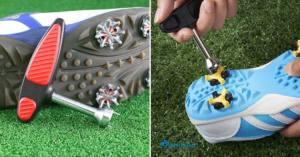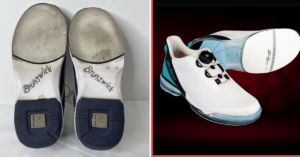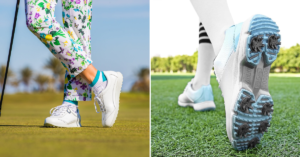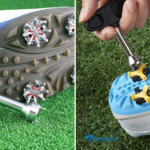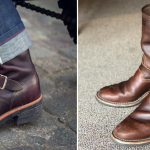Are your running shoes feeling a bit snug? Don’t worry, you’re not alone. Many runners face this common problem, especially with new shoes or after a long run when feet tend to swell. The good news is that there are several effective ways to stretch your running shoes for a more comfortable fit. In this blog post, we’ll explore various methods on how to stretch running shoes to help you achieve that perfect fit without damaging your precious kicks.
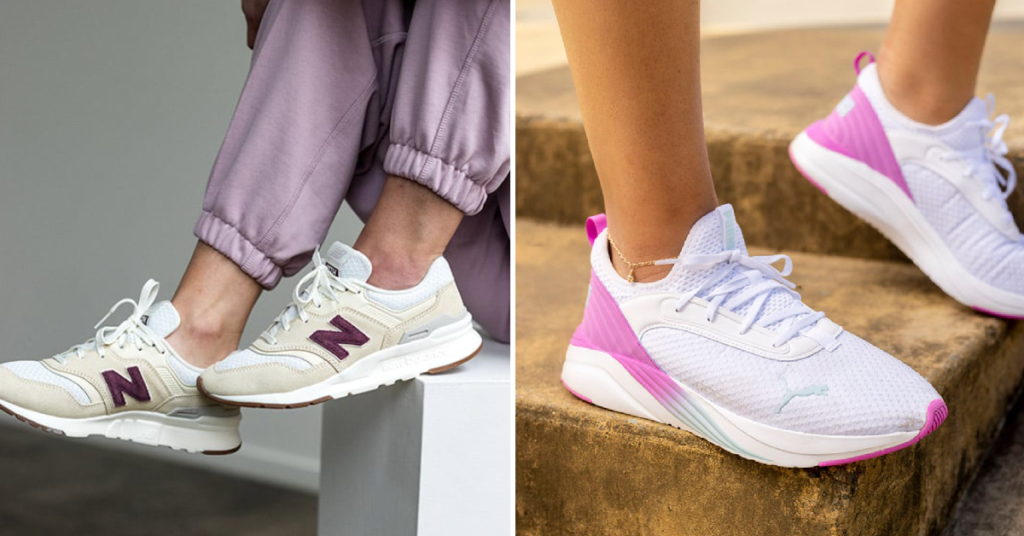
Quick Relief Methods
If you need immediate relief, try these quick fixes:
1. Wear Thick Socks and Walk Around
Put on the thickest pair of socks you own, squeeze your feet into your running shoes, and walk around your house for 20-30 minutes. The extra bulk from the socks will help stretch the shoes a bit. This method is particularly effective for minor tightness and can provide quick relief without any special tools or techniques.
2. Use a Shoe Horn
A shoe horn can help you slip into tight shoes more easily, reducing the strain on the heel area. While it doesn’t actually stretch the shoe, it can make wearing them more comfortable. Shoe horns come in various lengths and materials, with longer ones being particularly helpful for those with limited mobility.
3. Loosen the Laces
Sometimes, simply readjusting how you lace your shoes can provide relief. Try skipping eyelets in tight areas or using different lacing techniques to reduce pressure points. Experiment with various lacing patterns to find what works best for your foot shape and problem areas. Now, let’s move on to more thorough stretching methods.
The Thick Sock and Hairdryer Method
This method is great for stretching specific tight spots in your running shoes.
You’ll need:
- Thick socks
- A hairdryer
- Your running shoes
Steps:
- Put on a pair of thick socks – the thicker, the better.
- Squeeze your feet into your running shoes.
- Set your hairdryer to medium heat.
- Point the hairdryer at the tight areas of your shoes for about 30 seconds at a time. Be careful not to overheat any one spot.
- While the shoe is warm, flex your foot and wiggle your toes to help stretch the material.
- Repeat this process a few times, focusing on the tightest areas.
- Walk around in the shoes until they cool down.
This method works well because heat makes the shoe material more pliable, while the thick socks provide the stretching force. Just be careful not to overheat synthetic materials, as they can melt or deform. It’s best to keep the hairdryer moving and not focus on one spot for too long to prevent damage.
The Freezer Method
This method might sound strange, but it’s based on the principle that water expands when it freezes.
You’ll need:
- Zip-lock bags
- Water
- Your running shoes
Steps:
- Fill two zip-lock bags about 1/4 full with water. Make sure to remove all the air before sealing them.
- Place each bag inside your shoes, positioning them in the areas that need stretching (usually the toe box).
- Put your shoes in the freezer overnight.
- In the morning, remove the shoes and let them thaw for about 20 minutes.
- Take out the bags and try on your shoes.
As the water freezes and expands, it gently stretches the shoe material. This method works well for mesh and synthetic materials but use caution with leather shoes as excessive moisture can damage them. The freezer method is particularly effective for widening the toe box area, which is a common problem spot for many runners.
Using a Shoe Stretcher
For a more precise and controlled stretch, consider investing in a shoe stretcher. These devices allow you to target specific areas and gradually increase the stretch.
You’ll need:
- A shoe stretcher (available online or at shoe repair shops)
- Shoe stretching spray (optional)
Steps:
- If using a stretching spray, apply it to the inside of your shoe, focusing on tight areas.
- Insert the shoe stretcher into your running shoe.
- Turn the handle to expand the stretcher until you feel resistance.
- Leave the stretcher in place for 24-48 hours, occasionally tightening it a bit more.
- Remove the stretcher and try on your shoes.
Shoe stretchers are particularly useful for widening the toe box or addressing specific pressure points. They’re a bit of an investment but can be used multiple times on different pairs of shoes. Some shoe stretchers come with additional attachments for targeting specific areas like bunions or corns, making them versatile tools for various foot issues.
The Professional Touch
If you’re not comfortable stretching your shoes yourself or if you have expensive running shoes, consider taking them to a professional shoe repair shop. Cobblers have specialized tools and expertise to stretch shoes without damaging them. They can often address specific problem areas more effectively than home methods. Professional shoe stretching services typically cost between $15 to $25 per pair, which can be a worthwhile investment for high-end running shoes. Cobblers can also assess whether stretching is the best solution for your shoes or if other modifications might be more appropriate.
Stretching Sprays and Solutions
There are commercial shoe stretching sprays and solutions available that can help make the stretching process easier and more effective.
You’ll need:
- Shoe stretching spray or solution
- Your running shoes
Steps:
- Spray the inside of your shoes generously, focusing on tight areas.
- Put on the shoes immediately and wear them for at least 30 minutes.
- If possible, wear them while walking around to help the stretching process.
These sprays work by softening the material, making it more pliable and easier to stretch. They can be particularly effective when used in combination with other methods like wearing thick socks or using a shoe stretcher. Some popular brands include Foot Matters Professional Boot & Shoe Stretch Spray and Kiwi Select Universal Shoe Stretch.
The Wet Newspaper Method
This method is best for canvas or fabric running shoes, not leather or synthetic materials.
You’ll need:
- Wet newspaper
- Your running shoes
Steps:
- Dampen some newspaper with water. It should be wet but not dripping.
- Stuff the damp newspaper into your shoes, packing it tightly, especially in areas that need stretching.
- Leave the shoes in a warm, dry place overnight.
- In the morning, remove the newspaper and let the shoes air dry completely before wearing.
As the newspaper dries, it expands slightly, gently stretching the shoe material. This method can also help remove odors from your running shoes. It’s important to let the shoes dry completely before wearing them to prevent any moisture-related issues like mold or mildew.
The Rice Sock Method
This method combines heat and pressure to stretch your shoes.
You’ll need:
- A pair of socks
- Uncooked rice
- A microwave
- Your running shoes
Steps:
- Fill a pair of socks with uncooked rice.
- Microwave the rice-filled socks for about 30 seconds until they’re warm (not hot).
- Quickly stuff the warm rice socks into your running shoes.
- Leave them in place until the rice cools down completely.
- Remove the socks and try on your shoes.
The warmth from the rice helps soften the shoe material, while the weight provides gentle pressure to stretch it. This method is particularly effective for leather running shoes. You can repeat this process a few times for stubborn tight spots, but be careful not to overheat the shoes.
Tips for Maintaining Shoe Integrity
While stretching your running shoes can provide much-needed relief, it’s important to do so carefully to avoid damaging them. Here are some tips:
- Always start with gentle methods and gradually increase intensity if needed.
- Avoid excessive heat, which can damage synthetic materials or glued parts of the shoe.
- Don’t overstretch, aim for a comfortable fit, not a loose one.
- Be patient, gradual stretching over time is often more effective and less damaging than aggressive methods.
- If your shoes are consistently too tight, consider getting professionally fitted for your next pair.
Remember that running shoes are designed with specific support structures and materials. Overstretching can compromise these features, potentially leading to reduced performance or even increased risk of injury. It’s always better to err on the side of caution and stretch gradually.
Preventive Measures for Future Purchases
To avoid the need for stretching in the future, consider these tips when buying new running shoes:
- Get your feet measured regularly, as foot size can change over time.
- Shop for shoes later in the day when your feet are slightly swollen, similar to how they’ll be after a run.
- Bring your running socks when trying on new shoes.
- Consider the shape of your foot and choose shoes that match your arch type and width needs.
- Don’t be afraid to try different brands or models – what works for one runner may not work for another.
- Give yourself a thumb’s width of space between your longest toe and the end of the shoe.
By taking these precautions, you can reduce the likelihood of needing to stretch your running shoes in the future.
FAQs about Stretching Running Shoes
Can I stretch running shoes made of mesh?
Yes, mesh running shoes can be stretched, but be gentle. The freezer method or using a shoe stretcher with a stretching spray often works well for mesh materials.
How long does it take to stretch running shoes?
It depends on the method and material. Some quick fixes provide immediate relief, while more thorough methods like using a shoe stretcher might take 24-48 hours.
Will stretching my running shoes affect their performance?
Minor stretching shouldn’t significantly impact performance. However, overstretching can alter the shoe’s structure and support, potentially affecting its performance and durability.
Can I use the same methods to stretch both running shoes and casual shoes?
Many methods work for both, but running shoes often have more complex structures. Be extra careful with running shoes to maintain their supportive features.
Is it better to stretch shoes or break them in naturally?
A combination often works best. Start by wearing your shoes for short periods to break them in naturally, then use gentle stretching methods if needed.
Can stretching fix all shoe fit issues?
Stretching can help with minor fit issues, but it can’t fix major sizing problems. If your shoes are more than a half-size too small, it’s better to exchange them for a proper fit.
How often can I stretch my running shoes?
Avoid frequent stretching as it can weaken the shoe’s structure. If you find yourself needing to stretch your shoes often, it might be time for a new pair or a professional fitting.
Conclusion
Stretching your running shoes can be a game-changer when it comes to comfort and fit. From quick fixes like wearing thick socks to more involved methods like using a shoe stretcher, there are plenty of options to try. Remember to start with gentle methods and be patient gradual stretching is often more effective and less likely to damage your shoes. Always prioritize the health of your feet. If stretching doesn’t solve the problem, don’t hesitate to consult a professional or consider investing in a new pair of properly fitted running shoes. With the right fit, you’ll be able to focus on your run, not your feet. Happy running!
